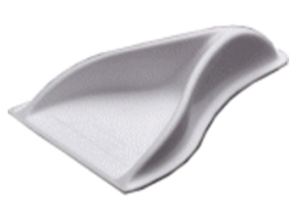AIRTAB®: A DISCUSSION PAPER
With the rapid rise in fuel prices the Airtab® product is beginning to attract more attention, including speculation on how they actually perform. This paper intends to shed more light on our product. The Airtab® shape is based on the National Advisory Committee on Aeronautics (NACA) submerged air inlet duct. (see Figure 1) The NACA Duct has been successfully used on aircraft fuselages and racing vehicles for decades. The impetus for the creation of the NACA duct came from the need to pull attached airflow into required spaces for various reasons (cooling, air conditioning, tank pressurization etc.) without using a high profile drag ram air scoop. Need for this innovative inlet duct became more urgent as aircraft and vehicle speeds increased.
AIRTAB®: Base Pressure Drag on Trailers
In January 1997, the U.S. Department of Energy (DOE) began a study on Heavy Vehicle Aerodynamic Drag. This is a Multi-year study that aims to reduce fossil fuel consumption by heavy trucks (class 8) through the reduction of aerodynamic drag coefficients. According to the Argonne National Laboratory, Class 8 trucks alone consume 18 Billion gallons of fuel each year. Although tractor manufacturers continue to reduce forebody aerodynamic drag by streamlining their products, little attention has been given to the base drag (suction) at the rear of trailers. To understand the relationship between forebody aerodynamic improvements and the trailer rear, let's examine this statement from a 1999 NASA report regarding forebody drag at the front of a tractor, and the effects on afterbody drag at the rear of the trailer. "Because base drag increases as forebody drag is reduced and these components of drag are additive, afterbody refinement (base drag reduction) will be required in order to achieve an overall aerodynamic drag coefficient of 0.25." What does this statement mean?
AIRTAB®: Attached Airflow
Why is it important for vehicle designers to have airflow stay “attached” to vehicles whether it is an auto, van, straight truck, tow trailer or tractor-trailer semi? This paper will address definitions of attached and separated airflow and their application to Class 8 tractor-trailers. By extension, this discussion would also apply to all large, bluff bodied ground transportation vehicles that spend a majority of their drive time at highway speeds. A “streamline” is a line that is parallel to the direction of flow of a fluid at a given instant or the path a given particle follows in a flowing fluid. A streamlined shape, therefore, is one that is constructed with a shape that offers a minimum resistance to fluid flow. Prime examples of streamlining are modern aircraft and just about any fish or sea mammal.
AIRTAB®: Tractors & Flatbeds
Does the back of a tractor look like the back of a trailer? From an aerodynamic standpoint, the answer is yes. Although their appearances differ somewhat because of the presence of side and roof fairings, a fully faired tractor bobtailing or hauling a flat bed and the back of a dry van or reefer trailer are aerodynamic equivalents. That is, they both create base pressure drag. BASE PRESSURE DRAG is an aerodynamic term that describes the “suction” or low PRESSURE area (which creates DRAG) that occurs at the BASE area (or at the back of) any bluff bodied object traveling at speed. A “bluff body” is another aerodynamic term that describes any square backed object. The backs of tractors, straight trucks, dry vans, reefers etc are perfect examples of bluff bodies. Consider the tractor with
AIRTAB®: Wind Resistance and Aerodynamic Drag
Wind resistance and aerodynamic drag is the MPG killer. All other things being equal, like weight of the vehicle, driving speeds, even driving habits, it is wind resistance that affects everything. Driving slower, no jack rabbit starts, using the brakes less, and discarding unnecessary items to reduce weight are all things you can do to help increase your fuel mileage. But whether you do any or all of these things, the one constant is wind resistance. You can’t eliminate wind resistance and drag, but you can reduce it, in some cases dramatically, to mitigate its effects on everything you do. When you drive down the road you must push the air in front of you out of the way. The mathematics of what happens as you do this can get very complicated, but what it all means is, when you push the air in front of you out of the way, it causes the air pressure in front of you, as well as around you to increase, and the area directly behind you will have reduced air pressure. This area of reduced air pressure is called “aerodynamic drag” because the reduced air pressure wants to “drag” you back into it.

